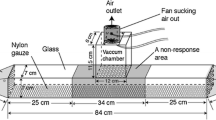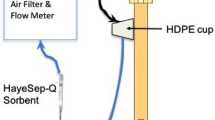Abstract
Since Varroa mites decide at some distance from the larva whether to stay on a bee or invade a cell, they may well use a volatile chemical to select a brood cell. A few aliphatic esters, predominantly methyl palmitate, have been claimed to be this volatile signal for the mites for two reasons. The mites respond to the esters in an olfactometer (Le Conte et al., 1989), and the levels of the esters in worker and drone larvae may explain that drone cells are attractive during a longer period and are invaded more frequently than worker cells (Trouiller et al., 1992). However, invasion itsclf appeared to be unaffected by application of methyl palmitate to brood cells. In addition, analysis of the volatiles emanating from attractive brood cells showed hundreds of components in the volatile blend, but in only 2 of 17 analyses a trace of methyl palmitate was found. Hence, there is no reason to believe that methyl palmitate is used as a signal for invasion by the mites.
Similar content being viewed by others
References
Beetsma, J., Boot, W.J. and Calis, J.N.M., 1993. Special techniques to make detailed observations of Varroa mites staying on bees and invading honeybee brood cells. In: L.J., Connor, T., Rinderer, H.A., Sylvester and S., Wongsiri (Editors), Asian apiculture. Wicwas Press, Cheshire CT, USA, pp. 510–520.
Boot, W.J. and Calis, J.N.M., 1991. A method to obtain dated brood in honeybee colonies. Bee World, 72: 19–21.
Boot, W.J., Calis, J.N.M. and Beetsma, J., 1992. Differential periods of Varroa mite invasion into worker and drone cells of honey bees. Exp. Appl. Acarol., 16: 295–301.
Boot, W.J., Beetsma, J. and Calis, J.N.M., 1994. Behaviour of Varroa mites invading honey bee brood cells. Exp. Appl. Acarol. 18: 371–379.
Boot, W.J., Driessen, R.G., Calis, J.N.M. and Beetsma, J., in press. Further observations on the correlation between attractiveness of honey bee brood cells to Varroa jacobsoni and the distance from larva to cell rim. Entomol. Exp. Appl.
Dicke, M., Van, Beek, T., Posthumus, M.A., Ben Dom, N., Van, Bokhoven, H. and De, Groot, Æ., 1990. Isolation and identification of volatile kairomone that affects acarine predator prey interactions: Involvement of host plant in its production. J. Chem. Ecol., 16: 381–396.
Goetz, B. and Koeniger, N., 1993. The distance between larva and cell opening triggers brood cell invasion by Varroa jacobsoni. Apidologie, 24: 67–72.
Ifantidis, M.D., 1988. Some aspects of the process of Varroa jacobsoni mite entrance into honey bee (Apis mellifera) brood cells. Apidologie, 19: 387–396.
Ifantidis, M.D. and Rosenkranz, P., 1988. Reproduktion der Bienenmilbe Varroa jacobsoni (Acarina: Varroidae). Entomol. Gen., 14: 111–122.
Le, Conte, Y., Arnold, G., Trouiller, J., Masson, C., Chappe, B. and Ourisson, G., 1989. Attraction of the parasitic mite Varroa to the drone larvae of honey bees by simple aliphatic esters. Science, 245: 638–639.
Le, Conte, Y., Arnold, G., Trouiller, J. and Masson, C., 1990. Identification of a brood pheromone in honeybees. Naturwissenschaften, 77: 334–336.
Trouiller, J., Arnold, G., Le, Conte, Y. and Masson, C., 1991. Temporal pheromonal and kairomonal secretion in the brood of honeybees. Naturwissenschaften, 78: 368–370.
Trouiller, J., Arnold, G., Chappe, B., Le, Conte, Y. and Masson, C., 1992. Semiochemical basis of infestation of honey bee brood by Varroa jacobsoni. J. Chem. Ecol., 18: 2041–2053.
Wirtz, P., 1973. Differentiation in the honeybec larva. Meded. Landbouwhogeschool Wageningen 73–5, 155pp.
Author information
Authors and Affiliations
Rights and permissions
About this article
Cite this article
Boot, W.J. Methyl palmitate does not elicit invasion of honeybee brood cells by Varroa mites. Exp Appl Acarol 18, 587–592 (1994). https://doi.org/10.1007/BF00051721
Issue Date:
DOI: https://doi.org/10.1007/BF00051721




